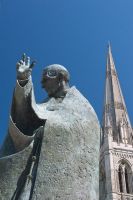
Take a close look at the spire. It is actually a Victorian restoration, and a very successful one at that, visible for miles away.
Interior Highlights
Chapel of St Michael
Also known as The Sailor's Chapel, this acts as a memorial to men and women of the Royal Navy all those people of West Sussex who lost their lives at sea during WWII.
Chapel of St George
This small chapel in the south aisle acts as a memorial chapel for the Royal Sussex Regiment. Wall panels list the names of nearly 8,000 soldiers of the regiment who died during WWI.
Chapel of St Clement
This delightful chapel in the south aisle dates to around 1300. It is dedicated to Clement, a 1st-century Bishop of Rome. To one side of the altar is the ornate tomb of Richard Durnford, Bishop of Chichester from 1870 to 1895.

Quire
The quire, or choir, has magnificent wooden stalls given by Bishop Langton and dating from around 1330. The fact that the stalls have survived mostly intact is miraculous; they escaped destruction when the cathedral tower collapsed in 1861.
The rear stalls boast thirty-eight medieval misericords, or mercy seats for the clergy to support them during long services. The quire floor is made of squares of black and white marble and was installed in 1731.
Arundel Screen
This beautifully carved 15th-century stone screen separates the nave from the quire. The screen was removed in 1859 to create more space but restored in 1961 after being kept in storage for over a century.
South Transept
There are two striking features in the south transept; the 1877 stained glass window, with scenes from the Bible depicted in stunning colour, and 16th-century wooden panels on the west wall with paintings showing the beginnings of Chichester Cathedral and the figure of King Henry VIII.
The painted panels were executed by a Chichester artist named Lambert Barnard and are thought to be the largest of their kind to survive. There is more outstanding Tudor art by Barnard in the north transept.

Chichester Reliefs
These richly-carved 12th-century stones were discovered hidden behind the choir stalls in 1829. They may have formed part of an elaborate chancel screen consisting of four pairs of panels, of which only this pair remain.
The relief carvings depict two Biblical scenes from the story of Lazarus; Christ Arriving in Bethany and the Raising of Lazarus. Architectural historians consider these two carved stones to be the most important historical features in the cathedral.
The carvings would originally have been painted and had small jewels inserted in the eye sockets of important figures. Both stones are clearly discoloured, probably from the effects of the destructive fire of 1187.
We've called the carvings 12th century, but some historians place the date much earlier, during the Saxon period, since the style of carving has much more in common with that period. It is possible that they were originally installed at Selsey and only brought to Chichester when the see was moved in 1075.
Roman Mosaic
The cathedral stands on the site of a large Roman house. In the south aisle you can see a section of Roman mosaic displayed under a glass panel set into the floor.

Shrine of St Richard
A destination for medieval pilgrims, the shrine to St Richard stands behind the high altar. This was the third most important pilgrimage site in medieval Britain, after only St Thomas Becket's shrine at Canterbury Cathedral and Our Lady of Walsingham in Norfolk.
Richard de Wych served as Bishop of Chichester from 1244 until his death in 1253. He was canonised in 1262. St Richard was first interred in the Chapel of St Thomas and St Edmund, on the north side of the cathedral nave, but later moved to a bejewelled silver shrine in its present location.
The shrine was destroyed by Henry VIII in 1538 and the saint's bones dispersed. Centuries later, a bone thought to belong to St Richard was returned to the cathedral and it is now buried beneath the altar. Its location is marked by a single sanctuary candle.
St Richard's shrine is flanked by the tombs of Bishops William Barlow and George Day, both of 16th-century date.
In the north transept is a memorial to composer Gustav Holst, set beneath a memorial to Holst's favourite 16th-century composer, Thomas Weelkes. The epitaph reads, 'The Heavenly Spheres make music for us', a reference to the piece for which Holst is best-remembered, The Planets suite.

Marc Chagall Window
Arguably the most popular piece of art in the entire cathedral, this stunning stained-glass window was installed in 1978. It is the work of Russian artist Marc Chagall and took fully nine years to complete.
The richly-coloured glass is Chagall's interpretation of Psalm 150, which reads in part, 'Let everything that has breath praise the Lord'. The window depicts every one of the musical instruments mentioned in the psalm as well as watching animals and birds.

North Transept
When the cathedral moved here from Selsey in 1075 it took over an existing church on the site, dedicated to St Peter. The north aisle is a surviving part of this 11th-century pre-cathedral building. Like the south aisle, this area features wonderful Tudor artwork by local artist Lambert Barnard.
The paintings on wooden boards are ostensibly portraits of all the Bishops of Chichester to that date, though they all share the same facial characteristics, that of Bishop Sherborne, who commissioned the work. The Barnard portraits are of national importance as outstanding examples of Tudor art.

The Arundel Tomb
In the north aisle stands the tomb of Richard Fitzalan, 2nd Earl of Arundel, and his wife, Eleanor of Lancaster. The Arundel tomb was brought to the cathedral from Lewes Priory when the priory was suppressed in 1537.
The tomb shows the effigies of the Arundels holding hands. It is this pose that inspired the Philip Larkin 1955 poem, 'An Arundel Tomb'.
Bradbridge Brass
One of the last surviving memorial brasses in the cathedral, this beautifully carved memorial commemorates William Bradbridge (d. 1546), three-time Mayor of Chichester, his wife, Alice, and their six sons and eight daughters.
The Cathedral Exterior
St Richard's Walk
This picturesque lane links the cathedral with Canon Lane and the Deanery and provides access to the Bishop's Palace and its wonderful gardens. Canon Lane is perhaps the most beautiful historic street in Chichester, with arched medieval gateways at each end. Just off Canon Lane is Vicar's Close, the medieval home of the Vicars Choral.

Bell Tower
Chichester is the only English cathedral with a campanile, or detached bell tower. The bell tower dates from around 1300 and stands at an angle to the west end of the cathedral. Sadly, the bell tower is listed on Historic England's Heritage at Risk Register as it is in urgent need of repair.
Statue of St Richard
Standing near the base of the bell tower is a modern sculpture of St Richard, crafted by Philip Jackson. The life-sized bronze statue was erected in 2000 to mark the Millennium. The statue stands on a plinth of Cornish granite, blue slate from Wales, and Portland limestone from Dorset.

In recent years peregrine falcons have taken to nesting in the tower, and on our visit hordes of bird watchers and photographers were clustered around the cathedral exterior hoping to catch a glimpse of the falcons.
A short walk from the cathedral brings you to the Bishop's Palace, official residence of the Bishop of Chichester. Though the palace is not open to visitors, you can stroll the Bishop's Palace Gardens, an oasis of greenery and floral splendour.
The best views of the cathedral itself can be had from the gardens, and on one side of the garden area you can walk along the old medieval city walls of Chichester.












 We've 'tagged' this attraction information to help you find related historic attractions and learn more about major time periods mentioned.
We've 'tagged' this attraction information to help you find related historic attractions and learn more about major time periods mentioned.


